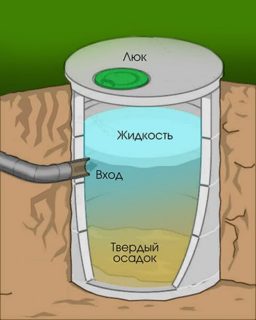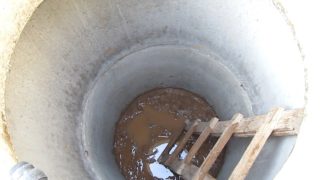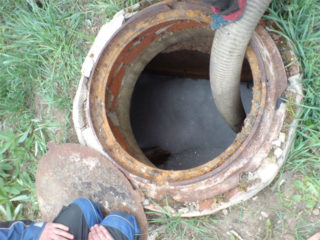A cesspool is an indispensable element of the sewage system in country houses. Sometimes the owners have a problem related to the rapid filling and poor outflow of water. If you do not find out in time the cause of the constant blockage of the cesspool, there is a risk of failure of the entire sewer system.
The main reasons for poor water outflow
This arrangement implies that all wastewater that has fallen into the cesspool will slowly soak into the ground through the walls and bottom. But over time, the drainage capacity of the reservoir decreases, water stagnates and a fetid odor appears nearby. The reason for this phenomenon may be hidden in the following.
- The appearance at the bottom of the cesspool of a large layer of silt, which has accumulated due to the constant flow of feces. The resulting crust prevents liquids from being absorbed.
- The appearance of a thick layer of fat at the bottom of the drain tank. More often, a combined problem arises, combining the formation of oily plaque and silting.
- At negative temperatures, the problem of poor absorption may be associated with severe soil freezing.
- A small volume of a cesspool. If too many people use the sewage system, additional water from household appliances flows into it, the process of filling the tank goes much faster.
Important! Sanitary standards prohibit building a cesspool on the site without sealed walls and bottom. This design causes significant harm to the environment. It is recommended to build the tank in such a way that, when filling it, simply pump out the accumulated liquid or dispose of it in the correct way through the drain.
Troubleshooting methods
Silting up with fecal matter
To remove the sludge, you will need a sludge sucker. With its help, you first need to remove all the sewage, after which the bottom is cleaned under high pressure with the help of water. Additionally, in case of heavy contamination, the crust is removed from the walls using brushes. Once all surfaces have been cleaned, you will need to rewash the receiver with high pressure water.
If the rind is thick, special bacteria will need to be added to the water to clean up faster. But it is important to remember that they are active only in a humid environment at a positive air temperature.
Elimination of oily film
You can also remove plaque by flushing the system and using chemicals. The resulting fat is well eaten away by bacteria that turn it into compost and water. But since drains often contain impurities of powders and other cleaning agents, bacterial preparations cease to function. If no detergent components get into the drain, it is recommended to add bacteria such as "Vodogray" and "Microbec" to the receiver.Additionally, they compost toilet paper and accelerate the decomposition of food.
If bacteria are powerless, nitrate oxidants, formaldehydes and ammonium compounds should be used. After getting on the faecal sludge and fat, the product quickly reacts and dissolves the crusts. The safest for humans and nature are nitrate oxidants. The mass formed after their use is allowed to be used as compost for plants. If the choice is made towards ammonia, they should be used only in the warm season, otherwise there will be no result. Formaldehydes are allowed to be used only in emergency cases, as they practically destroy all plants within a radius of 10 meters.
Important! When using equipment and agents against silting and the formation of a greasy film, it is also necessary to additionally clean the collector.
Freezing of the earth
Insufficient receiver volume
If, for some reason, the existing tank size is no longer enough, you will need to increase it. This is done quite simply. It is enough to dig another receiver nearby, which will be connected to the first one using a drain pipe. As soon as the level of the first cesspool is critical, all waste will go to the second compartment.
Preventive measures for clogging the cesspool
In order to prevent disruption of the operation of the cesspool and stagnation of water in it, it is enough to follow the recommendations to protect the drain from grease and silting.
- It is required to promptly pump out all the sewage from the tank, while not allowing it. It is especially important to clean out the drain before the cold weather begins, if you do not plan to use it in the winter.
- Periodically rinse the walls and bottom of the sump under high pressure. It is recommended to carry out such work at least once a year, but for the smooth functioning of the tank, it is better to do this every six months.
- In the summer, special chemicals and bacteria should be poured directly into the drain, which kill the unpleasant odor and remove the fatty film from the surface of the drain pit.
- Before starting the construction of the receiver, it is required to correctly calculate its volume and depth.
- It is impossible not to take into account the point of freezing of the soil in a particular region.
- If the winters are cold, you should consider insulating the runoff.
If you follow all preventive measures and properly care for the cesspool, it will not cause any problems and will last as long as the owners need.












Have you thought about the neighboring wells?
If silted up - a bag of saltpeter! Tested!
What a bag of saltpeter7
Saltpeter, sulfur and coal
This is a violation of the law….
The sewer well cannot filter,
only pumping out and removal to filtration fields!
The author is a goon!
A pack of shivers
Forgot to write that the groundwater is close, water comes from the bottom more than from the drains
And not a dunce, the author. According to SanPin, of course it is not correct, the bottom should be concreted, but at the same time many do it as it is written.
All of you goonies! Now modern toilets of the type (Topaz) allow the settled water to be drained into cesspools!
I have been operating five communication wells for more than 13 years. During this time, I once pumped it out with a "barrel" and once in the first well washed away solid deposits with a high pressure washer, otherwise without any problems. I live in the house all year round.
Yes You are right communicating wells are needed, and you can not worry for many years.